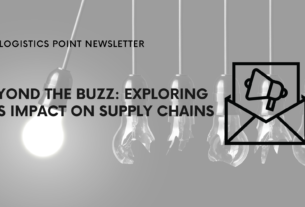By Tony Player, Domain Principal, Supply Chain at Anaplan
In recent years, organisations have recognised the inherent business risk associated with a fragile supply chain ecosystem, elevating supply chain resilience to a boardroom discussion. It’s clear that an agile, streamlined supply chain operation is critical to a company’s ability to stay stable in a volatile economic environment.
This is a major concern given the International Monetary Fund’s (IMF) forecast of a 0.3% contraction in the UK economy in 2023. A rise in extreme climate events and the transition to Net Zero further underscore the urgency. This is driving an increasing number of UK businesses to raise the alert regarding the resilience of their supply chains.
It’s a wake-up call for UK manufacturers in particular, given their reliance on the import of raw materials, ingredients, and components. The UK relies heavily on global supply chains for products ranging from food and machinery to semiconductor chips. These supply chains are already under pressure due to years of disruptions brought on by the pandemic, and now weather-related change is taking its toll.
The Climate Change Committee’s Climate Change Risk Assessment emphasises a significant lack of resilience in the UK’s domestic and international supply chains, which is supported by the government’s risk assessment. Earlier this year, for instance, weather conditions had a negative impact on harvest in Europe and North Africa, leading to a shortage of imported vegetables in the UK.
For UK manufacturers there is an urgent need to not only mitigate climate-driven risks and disruptions in the short term to protect profit margins but to re-think long-term strategies to deliver a more sustainable supply chain operation while also aligning with evolving ESG regulations and the Net Zero transition.
So how can UK manufacturers act now to reduce their vulnerability, build their resilience, and drive more responsible–and profitable–operations into the future?
While it’s a complicated challenge, the following are my recommendations as to where UK manufacturers should start.
Identify and actively manage risk
Unexpected climate-related events can profoundly disrupt supply chain operations, from manufacturing plants to transport networks. While manufacturers cannot predict individual environmental disasters, they can plan ahead to prepare their supply chains for increased volatility and climate-related events.
Actively assessing and managing risk is a critical first step and an exercise that should be done on a continuous basis. A supply chain digital twin, which essentially provides a virtual copy of a physical supply chain ecosystem, can enable manufacturers to contextualise risk across their entire network of suppliers and partners. Decision-makers can combine data from suppliers and producers, warehouses facilities, and logistics providers, with real-time signals from external data sources, such as weather data. This comprehensive data mix can help manufacturers identify supply chain vulnerabilities.
After identifying these weak points, developing ‘what-if’ scenario models is an excellent way to stress-test supply chain plans, forecasts, and operations. Leaders can examine the impact of a potential climate event on a specific planning model, such as a standard inventory or assortment model, in both the short and long term. They can then implement contingency plans based on predicted outcomes, which can speed up decision-making in the event of a disruption.
Re-forecasting often
Unexpected weather events are likely to continue disrupting normal operations, new regulations will shift existing targets, and a general sense of uncertainty will linger for years to come. Manufacturers should realise that forecasting can no longer be done on a yearly or even quarterly basis and instead adopt a more continuous approach.
Forecasting on a more regular basis–using external signals as well as data from up and down the supply chain–can help manufacturers mitigate business risk in the short term, while also identifying long-term growth opportunities.
Running real-time scenarios in the Anaplan platform has helped Del Monte, one of the world’s leading producers, distributors, and marketers of fresh fruits and vegetables, stay on top of production and predict and accommodate market changes in real time. Where unforeseen events, like El Niño, used to make it challenging to prioritise product allocation, now Del Monte can run real-time scenarios to see what areas of the supply chain might not be profitable, then adjust strategies to limit food waste and increase profitability.
Establish communication channels with partners and suppliers
Real-time communication and visibility are also critical to ensure a continuous flow of goods. With so much change happening at such a rapid pace, manufacturers need to collaborate closely with their supply chain partners to avoid jeopardising profits. Establishing a single, real-time data hub–using a cloud-based platform, for instance–can help manufacturers remain in constant dialogue with their suppliers and partners on topics such as pricing, sourcing and production, downtime, workforce, and carbon emissions.
Opening the lines of communication will not only help manufacturers stay on top of unplanned weather-related disruptions, but it will also help organisations track their progress toward Net Zero goals and targets.
The transition to Net Zero will not happen overnight, and, with the cost-of-living crisis, Brexit-related policy negotiations, and ongoing geopolitical turmoil, it will be a fluid conversation at best. New regulations and reporting requirements will be implemented, goals and targets will shift, and a business’s ability to re-calibrate and adjust will be critical to success. With greater supply chain transparency, however, manufacturers will be able to accurately manage and report progress and work with partners to make the necessary adjustments if and when regulations shift.
A more nimble and sustainable future
Given the UK’s reliance on global supply chains, preparing operations for the impact of a changing climate—from extreme weather events to shifting ESG principles—should be a top priority for UK manufacturers in 2023 and beyond.
This will likely mean a change in processes and a change in thinking. Strategies and plans will need to evolve over time, just as the world around us continues to shift. That means actively managing risk, stress testing, and forecasting on a regular basis, and maintaining open lines of communication with supply chain partners to stay ahead of the negative impacts of weather events, or to address new policies or regulations.
These foundational changes can assist UK manufacturers in addressing vulnerabilities, navigating weather-related volatility, and building more resilient and sustainable supply chains. ✷



